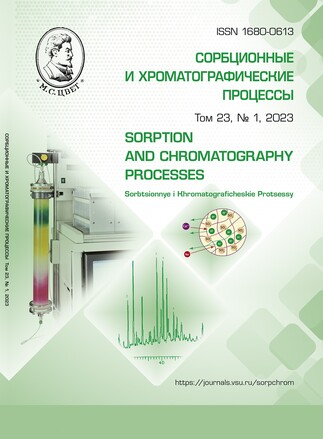Sorption of nootropics from aqueous media with activated carbon Norit® PK 1-3
Abstract
Recently, the amount of pharmaceutical waste and the contamination of surface and ground waters with drugs built up and, as a result, the toxicological risk for living organisms has increased. Activated carbons are common sorbents for extracting pollutants of various origins from waters, including organic pollutants.
With the use of Norit PK 1-3 active carbon, derived from peat, the sorption of nootropics (NT) - a pharmacological group of correctors of cerebral circulation disorders, of synthetic and natural origin - vinpocetine (VP), cinnarizine (CN), gamma-aminobutyric (GABA) and nicotinic (NA) acids was investigated.
With a sorbent weight of 0.10 g, a solution volume of 100 ml, and a phase contact time of 1 h, the degree of NT extraction was 52-95%, and the maximum adsorption capacity was 7.8-72.5 mg/g. The degree of extraction depends on pH and for NA it is maximal in the range from 5 to 11, for VP and CN it is maximal in the range from 7 to 13. GABA is maximally extracted at pH 7. The effect of pH on the extraction efficiency is due to the attraction of opposite charges between the surface of the sorbent and the dissociated form of NT. The sorption kinetics is described by a pseudo-second order model, sorption isotherms (type I) are described by the Langmuir model.
It has been established that sorption depends on the nature of the sorbate – acidity, hydrophobic parameter, the polar surface area of the molecule, the content of various forms of the sorbate in solution [calculated using the MarvinSketch ver. 22.6 (Chemaxon) program] and the charge of the sorbent surface. In addition to hydrophobic interactions, NT are characterized by π-stacking and dipole-dipole interactions.
Downloads
References
Gupta R., Sati B., Gupta A. Treatment and recycling of wastewater from pharmaceutical industry. Advances in biological treatment of industrial waste water and their recycling for a sustainable future. ap-plied environmental science and engineer-ing for a sustainable future. Springer, Singapore. 2019: 267-302. https://doi.org/10.1007/978-981-13-1468-1_9
Riva F., Castiglioni S., Fattore E., Manenti A., Davoli E., Zuccato E. Monitor-ing emerging contaminants in the drinking water of Milan and assessment of the hu-man risk, Int. J. Hyg. Environ. Health. 2018; 221: 451-457. https://doi.org/10.1016/j.ijheh.2018.01.008
Gadipelly C., Pérez-González A., Yadav G., Ortiz I., Ibáñez R., Rathod V., Marathe K., Pharmaceutical industry wastewater: review of the technologies for water treatment and reuse, Ind. Eng. Chem. Res., 2014; 53: 11571-11592. https://doi.org/10.1021/ie501210j
Kushnir A.A., Sukhanov P.T., Sizo K.O., Determination of nootropics in medicines, biological objects and food additives (review), Vestnik Voronezhskogo gosudarstvennogo universiteta. Seriya: Khimiya. Biologiya. Farmatsiya. 2021; 1: 5-19. (In Russ.)
Postigo C., Richardson S.D. Trans-formation of pharmaceuticals during oxidation/disinfection processes in drinking water treatment. J. Hazard. Mater. 2014; 279: 461-475. https://doi.org/10.1016/j.jhazmat.2014.07.029
Bingbing Q., Qianni S., Jicheng S., Chenhao Y., Huaqiang C., Application of biochar for the adsorption of organic pollutants from wastewater: Modification strategies, mechanisms and challenges. Sep. Purif. Technol. 2022; 300: 121925. https://doi.org/10.1016/j.seppur.2022.121925
Gęca M., Wiśniewska M., Nowicki P., Biochars and activated carbons as adsorbents of inorganic and organic compounds from multicomponent systems – A review, Adv. Colloid Interface Sci., 2022; 305: 102687. https://doi.org/10.1016/j.cis.2022.102687
El-Sayed Y., Bandosz T.J., Effect of Increased basicity of activated carbon sur-face on valeric acid adsorption from aqueous solution activated carbon. Phys. Chem. Chem. Phys. 2003; 5: 4892-4898. https://doi.org/10.1039/B306983B
Lladó J., Solé-Sardans M., Lao-Luque C., Fuente E., Ruiz B. Removal of pharmaceutical industry pollutants by coal-based activated carbons, Process Saf. Envi-ron. Prot. 2016; 104: 294-303. https://doi.org/10.1016/j.psep.2016.09.009
Alves C.C., Franca A.S., Oliveira L.S., Removal of phenylalanine from aqueous solutions with thermo-chemically mod-ified corn cobs as adsorbents. LWT-Food Science and Technology. 2013; 51(1): 1-8. https://doi.org/10.1016/j.lwt.2012.11.012
Doulia D., Rigas F., Gimouhopoulos C., Removal of amino acids from water by adsorption on polystyrene resins, J. Chem. Technol. Biotechnol., 2013; 76(1): 83-89. https://doi.org/10.1002/1097-4660(200101)76:1<83::AID-JCTB345>3.0.CO;2-N
Kushnir A.A., Sukhanov P.T., Savvina A.G., Bondareva L.P., Churilina E.V., Poluzhenkova E.V., Shatalov G.V., Sorp-tion of aromatic acids from aqueous solutions by polymer based on N-vinylpyrrolidone, Russ. J. Appl. Chem., 2016; 89: 891-896. https://doi.org/10.1134/S1070427216060070
Lim A., Chew J.J., Ngu L.H., Ismadji S., Khaerudini D.S., Sunarso J., Synthesis, characterization, adsorption iso-therm, and kinetic study of oil palm trunk-derived activated carbon for tannin removal from aqueous solution. ACS omega. 2020; 5(44): 28673-28683. https://doi.org/10.1021/acsomega.0c03811
Mojoudi N., Mirghaffari N., So-leimani M., Shariatmadari H., Belver C., Bedia J., Phenol adsorption on high microporous activated carbons prepared from oily sludge: equilibrium, kinetic and thermodynamic studies, Scientific Reports, 2019; 9(1): 19352. https://doi.org/10.1038/s41598-019-55794-4
Sviridova E.S., Voronyuk I.V., Eliseeva T.V., Selemenev V.F., Mukhin V.M. Comparison of the sorption of 4-hydroxybenzaldehyde by activated carbon of different grades under static conditions. Sorbtsionnye i khromatograficheskie protsessy. 2022; 22(1): 50-57. (In Russ.) https://doi.org/10.17308/sorpchrom.2022.22/9020
Egunova O.R., Shtykov S.N. Con-centration of some antibiotics of the fluoroquinolone series by magnetic solid-phase extraction on magnetite nanoparticles, Sorbtsionnye i khromatograficheskie protsessy, 2018; 18(6): 825-835. (In Russ.). https://doi.org/10.17308/sorpchrom.2018.18/610
Namasivayam C., Senthilkumar S., Removal of Arsenic (V) from aqueous so-lution using industrial solid waste: adsorp-tion rates and equilibrium studies. Ind. Eng. Chem. Res. 1998; 37: 4816-4822.
Mohamed E.F., Andriantsiferana C., Wilhelm A.M., Delmas H., Competitive adsorption of phenolic compounds from aqueous solution using sludge-based acti-vated carbon, Environ. Technol., 2011; 32(12): 1325-1336. https://doi.org/10.1080/09593330.2010.536783







